GUIDE TO THE IMPERIAL CITY IN HUE [VIETNAM]

WHAT TO SEE IN IMPERIAL CITY IN HUE? WHAT IS THE BEST WAY TO VISIT THE CITADEL IN HUE?
Hue was the capital of Vietnam throughout the 19th and early 20th centuries. The center of the Nguyen Empire still exists: the Imperial City of Hue. With its high stone walls and the elaborate palaces and temples behind it, The Citadel was the center of Vietnamese governance and politics during the reign of the Nguyen Kings.
If you’ve visited the Forbidden City in Beijing, then think of it as something very similar.
Listed by UNESCO in 1993, It is the most famous and visited monument in Hue. In this post we tell you all you need to know about your visit to the Imperial Citadel, a must see in Hue and Vietnam!
READ: 13 AMAZING THINGS TO SEE IN HUE, VIETNAM
Key Takeaways from a visit to the Imperial City in Hue:
– Hue Citadel covers approximately 520 hectares, located near the banks of the Perfume River.
– The inner sanctum is still open to the public as it undergoes continuous renovation.
– Most of the buildings were destroyed during the Tet Offensive in 1967, with US bombs helping push back invading North Vietnamese troops in Hanoi.
Some beautiful impressions of the Imperial City in Hue:
IMPORTANT INFORMATION FOR VISITING THE IMPERIAL CITY IN HUE

How to get there: From your hotel in Hue you can easily access the the Imperial City by taxi, cyclo or your own bicycle.
Visiting Hue on a day trip from Da Nang or Hoi An: it is possible to visit Hue on a day trip, either private or with a group. There is 2.5 to 3h drive to get to Hue, but it’s absolutely worth it if you did not plan to spend the night in Hue. More info here.
- Where is the citadel: click here to open the map
- Entrance fee to Hue Citadel: 150,000 vnd, children 7 to 12 years old 30,000 vnd
- Opening hours: The citadel is open every day (6:30 a.m. to 5:30 p.m. in summer and 7:00 a.m. to 5:30 p.m. in winter)
- Duration: Visiting Hue Citadel will take you about two hours and involves a fair amount of walking.
To fully enjoy your visit, you will need:
- Comfortable shoes
- Camera
- Water; Alternatively, you can also buy water at some of the many refreshment stalls in the Citadel Park.
Guide: to fully appreciate your visit and understand what you are actually seeing inside the Citadel, we highly recommend taking a guide with you. Prices are usually very affordable and it will make your visit much more interesting for such an important sight in Vietnam. You can book a guide here
THE HISTORY OF THE IMPERIAL CITY

The Citadel in Hue was where the 9 Nguyen Kings of the Nguyen Dynasty chose to live and rule the country. To be precise, in 1803 Emperor Gia Long himself surveyed the land to choose a suitable place to build this massive complex. In fact, it took 31 years to complete, from 1802 to 1833. The Imperial City is located inside the Citadel. It was recognized in 1993 as a UNESCO World Heritage Site.
The city of Hue will be the capital, as this place was chosen very carefully. The river and mountains surrounding Hue were said to resemble snakes and lions. It was the perfect place to recreate a version of Beijing’s Forbidden City.
In addition, the emperor planned the architectural system according to the principle of good proportion. In addition, around Hue Citadel, there are a total of 10 gates and a 7 km long moat for decoration, protection, and as a natural air conditioner.
This dynasty will be the last in Vietnam and will reign for 143 years.
THINGS TO SEE IN THE IMPERIAL CITY
1. FIRST STOP IN THE IMPERIAL CITY IN HUE: THE MAJESTIC NGO MON GATE
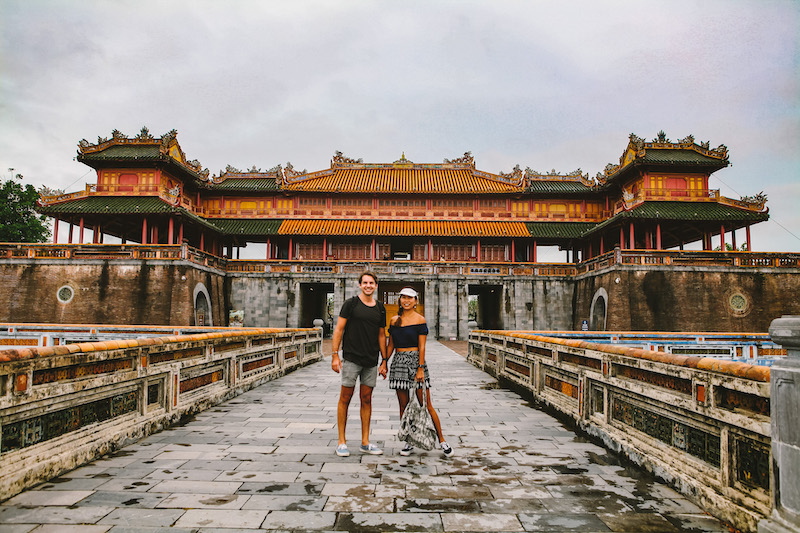

The Ngo Mon Gate is a massive structure that also served as a royal viewing platform for court ceremonies. The gate has some interesting architectural elements, each playing an important role in court ceremonies.
The gate can also be called Meridian Gate or Moon Gate.
Here are the main elements:
- The Doors: two of the five entrances that pass through the thick stone ramparts serve as entry and exit points for tourists. The largest door in the middle is barred (it was reserved for the use of the emperor). The two entrances flanking the Emperor’s Gate were reserved for mandarins and court officials, while the outermost entrances were reserved for soldiers and war material.
- The Observation Deck: The “Belvedere of the Five Phoenixes”, the Emperor’s private observation deck at the top of the gate, hosted the Emperor and his retinue during important court ceremonies . No women were allowed at this level; from this point of view, the emperor and his mandarins observed the military exercises.
- Flag Tower: In front of Ngo Mon Gate, on the other side of Ngo Mon Square, you can see the Vietnamese national flag waving from the flag tower. The three terraces that make up the platform of the Flag Tower were built in 1807.
The Ngo Mon Gate was by far the big highlight of the Imperial City in Hue. The building is absolutely stunning.
After passing this Gate, you are inside the Citadel. Here there are many buildings to visit and a huge park.
2. THE PALACE OF THE SUPREME HARMONY
Directly in line with the Ngo Mon Gate along the central axis of The Imperial City in Hue, the Throne Palace can be reached after walking 100 meters over a bridge known as the Trung Dao (Central Path) which crosses a pond known as Thai Dich.
Immediately after crossing the bridge, you will enter the Court of Great Rites, where mandarins used to gather to pay homage to the emperor. The lower half, farther from the throne palace, was reserved for village elders and lower-ranking ministers. The upper half of the courtyard was reserved for high-ranking mandarins.
The Throne Palace (which was unfortunately under renovation during our visit (September 2022), also known as the Palace of Supreme Harmony, was the nerve center of the Emperor’s court during its heyday. Built in 1805 by Emperor Gia Long, the Throne Palace was first used in 1806 for the Emperor’s coronation. Over the years, the throne palace has become the privileged setting for the most important ceremonies of the Empire, such as the coronation of emperors and crown princes, and the reception of foreign ambassadors.
The throne palace was built to host large ceremonies: the building is 44 meters long, 30 meters wide and almost 12 meters high, supported by red lacquered columns intertwined with golden dragons. On the throne hangs a carved board bearing the words “Palace of Supreme Harmony”.
3. THE MANDARIN BUILDINGS

Immediately behind the Throne Palace, visitors can pass a giant replica of the Emperor’s Great Seal and enter the plaza flanked by two Mandarin buildings. These buildings were annexed to the throne palace; they served as administrative offices for the cream of the Imperial civil service and as staging areas for important meetings with the Emperor.
National exams (inspired by those in China) were also held here for students wishing to enter the imperial civil service. The emperor took a personal interest in the examinations and himself assigned positions to those who passed the imperial examinations, in a grand ceremony in front of the Ngo Mon gate.
Today, the buildings house souvenir shops; the Mandarin building on the right houses a museum of imperial trinkets.
4. ROYAL READING ROOM
The Royal Forbidden City stood on the grassy field just past the Mandarin Buildings; the Emperor’s private quarters stood here before American bombs destroyed them in the 1960s. The Royal Reading Room (Thai Binh Lau) is the only building to survive the ravages of the 20th century. French reoccupation failed to destroy it; American bombs failed to bring it down.
Thai Binh Lau was built by Emperor Thieu Tri between 1841 and 1847. Emperor Khai Dinh then restored the temple in 1921, and civil authorities continued restoration efforts in the early 1990s. In the old At the time, emperors would retreat to Thai Binh Lau to read books and write letters.
5. THE QUEEN RESIDENCE: DIEN THO

From the grassy field that was once the emperors’ private quarters, turn southwest and you’ll find a long covered hallway, that leads to a complex housing the Queen Mother’s residence: the Dien Tho Residence.
Dien Tho Residence has several important buildings within its walls: Dien Tho Palace, Phuoc Tho Temple and Tinh Minh Building.
Dien Tho Palace: Built in 1804 as the home and audience hall of the Queen Mother, the importance of the building grew in proportion to the growing influence of the Queen Mother in Vietnamese affairs.
The palace was partially damaged during the wars of the 20th century but underwent extensive renovation between 1998 and 2001. The current appearance of the palace approximates its condition during the reign of the last Emperor Bao Dai. The front apartment looks like it did when Queen Mother Tu Cuong lived there in the 1st half of the 20th century, a sumptuous living space finished in dark lacquer and gold. Most of the other items were possessions of the Queen Mother’s household.
Phuoc Tho Temple: Located behind the Dien Tho residence, this temple served as a Buddhist temple and the Queen Mother’s personal shrine. Here, the Queen Mother celebrated religious anniversaries and performed rituals on auspicious days of the lunar month. The upper floor is called the Khuong Ninh Pavilion.
Tinh Minh Building: Standing on the side of Dien Tho Residence, this fairly modern looking building stands on the site of a wooden building named Thong Minh Duong.
6. TO MIEU TEMPLE

The large ornate gate in front of the Dien Tho building takes you out of the complex; turn right and follow the road for about 70 meters, then turn right at the corner and walk about 100 meters until you come to another beautifully decorated gate on your left (Chuong Duc) which serves as the entrance into the Mieu and Hung Mieu complex.
Two temples still stand within the walls of the enclosure: the To Mieu, where the Nguyen emperors are honored, and Hung To Mieu, built to consecrate the memory of the parents of Emperor Gia Long. On the death anniversaries of emperors, the reigning emperor and his retinue would perform the appropriate To Mieu ceremonies. The lacquered altars in the main gallery each honor one of the Nguyen emperors.
Originally there were only 7 altars: the French lords prevented the Nguyen emperors from installing altars to honor the anti-French emperors Ham Nghi, Thanh Thai and Duy Tan. The three missing altars were included in 1959, after the French left.
8. HIEN LAM PAVILION

In front of the Hien Lam Pavilion are nine urns: dynasty urns honoring emperors who have completed their reigns. The nine dynastic urns were cast in the 1830s. As they represent the reigns of successive Nguyen emperors, the urns were designed with massive proportions: each urn weighs between 1.8 and 2.9 tons, and the smallest urn is 1.90 meters high. Traditional designs representing the reign of each emperor were chiseled on each urn.
The Hien Lam Pavilion, also known as the Pavilion of Glory to Come, commemorates the lives and achievements of important commoners who helped the Nguyens rule their empire. The gate that leads outside the temple compound is right in front of the Hien Lam Pavilion. Turn left, walk about 200 meters and you will arrive where you started, at Ngo Mon gate.
OTHER THINGS TO SEE IN HUE
Hue was one of the main highlights of our trip to Vietnam, thanks to its historical and cultural values. We learned a lot from our guide about the history of Vietnam and the Kings. It was fascinating.
There are many things to see in Hue, which we listed in this post.
Some of the highlights are:
- THIEN MU PAGODA
- TAKING A CRUISE ON THE PERFUME RIVER
- MAUSOLEUM OF EMPEROR KHAI DINH
- THE TOMB OF TU DUC
- THAN TOAN JAPANESE BRIDGE
BEST HOTELS IN HUE?
There are many amazing places to stay in Hue, some are big resorts by the river, some are charming homestays and you can even find beautiful villas all to yourself!
Here is a selection of a few of our favorite hotels in Hue.
Pilgrimage Village Boutique Resort & Spa – $$$$

This is probably the most amazing place in Hue! If the nightly rate fits your budget, then without a doubt this is for you! The hotel is just breathtaking at every aspect. This luxury resort, just a few minutes from the main attractions in Hue, has a beautiful pool, serves amazing breakfast, the rooms are spacious and comfortable and the entire service top notch!
If you are looking for the best hotel in Hue, this one would be hard to beat!
Saigon Morin Hotel – $$$$
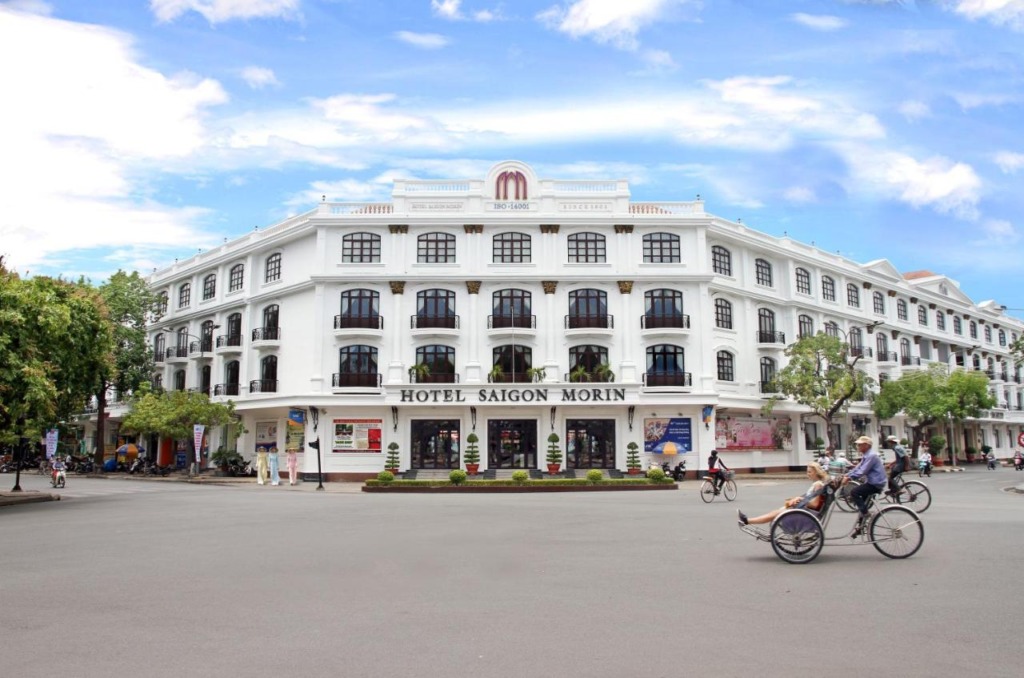
Saigon Morin Hotel is another beautiful hotel located in the center of Hue near the Imperial Citadel, which makes it a very convenient place to visit Hue.
This Hotel is a fantastic piece of history, as the building is a historical place featuring French colonial architectural style. We love this place too and would recommend it to anyone coming to visit Hue.
Hue River Side Villa – $$$

Why not stay in your own villa during your visit to Hue? The villas are located by the Perfume River, featuring a magnificent view from the garden! The location is perfect; you are in the center of Hue but still out of the hustle and noise of the city.
Le Robinet Homestay – $$
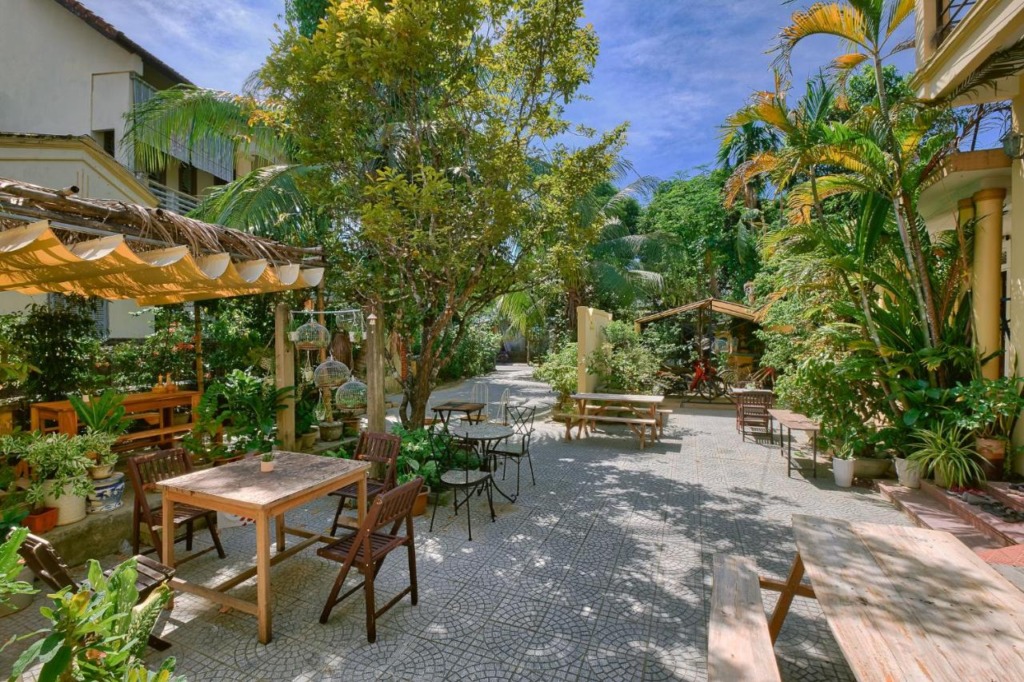
If you are more on a budget during your trip to Vietnam, then we recommend the charming Le Robinet Homestay. This is one of the best value for money. The place is super clean and the staff is super friendly! This place has a lot of character, reflecting how wonderfully unspoiled Hue is, and its wonderful slow pace.

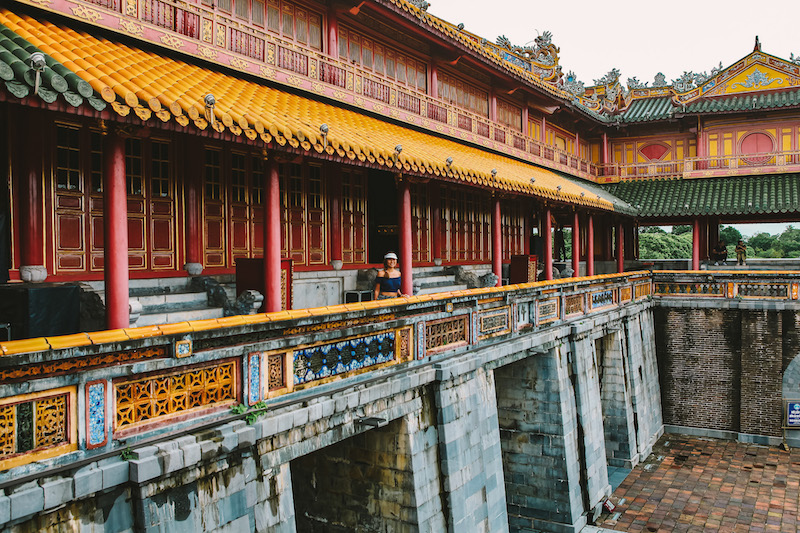
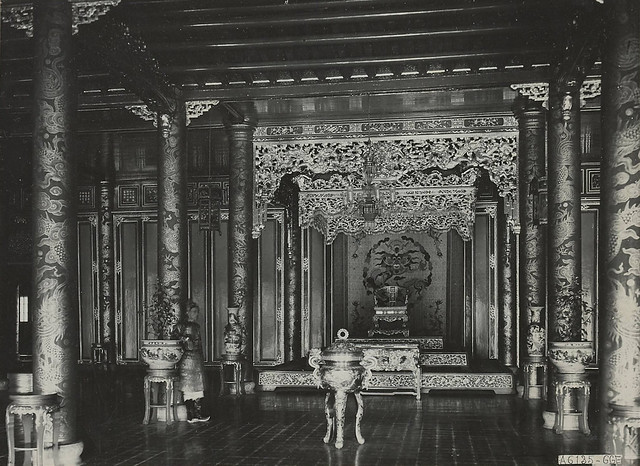


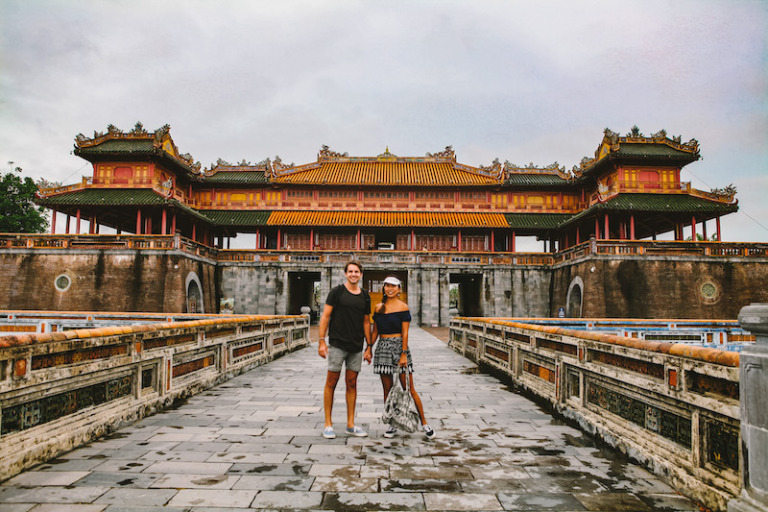

![GUIDE TO THE MARBLE MOUNTAINS IN DA NANG [VIETNAM]](https://afuncouple.com/wp-content/uploads/2022/10/Marble-Mountains-in-Da-Nang-in-Vietnam-6-768x512.jpg)
![10 BEST THINGS TO DO IN KANDY [SRI LANKA]](https://afuncouple.com/wp-content/uploads/2022/09/Best-things-to-see-in-Kandy-768x512.jpg)
![16 BEST THINGS TO SEE IN KARUIZAWA [JAPAN GUIDE]](https://afuncouple.com/wp-content/uploads/2023/02/Best-things-to-do-in-Karuizawa_Japan-11-768x512.jpg)
You should caution that cars are not permitted to enter the Citadel. The walk from the closest drop-off point would have tired me out before I got to the first attraction within the wall. I could have walked between the buildings, but this was too much, and I missed everything. Pity.
Hi Dave, thanks for your remark. Indeed the entire citadel must be visited on foot… Sorry to hear about your unpleasant experience at the citadel in Hue…